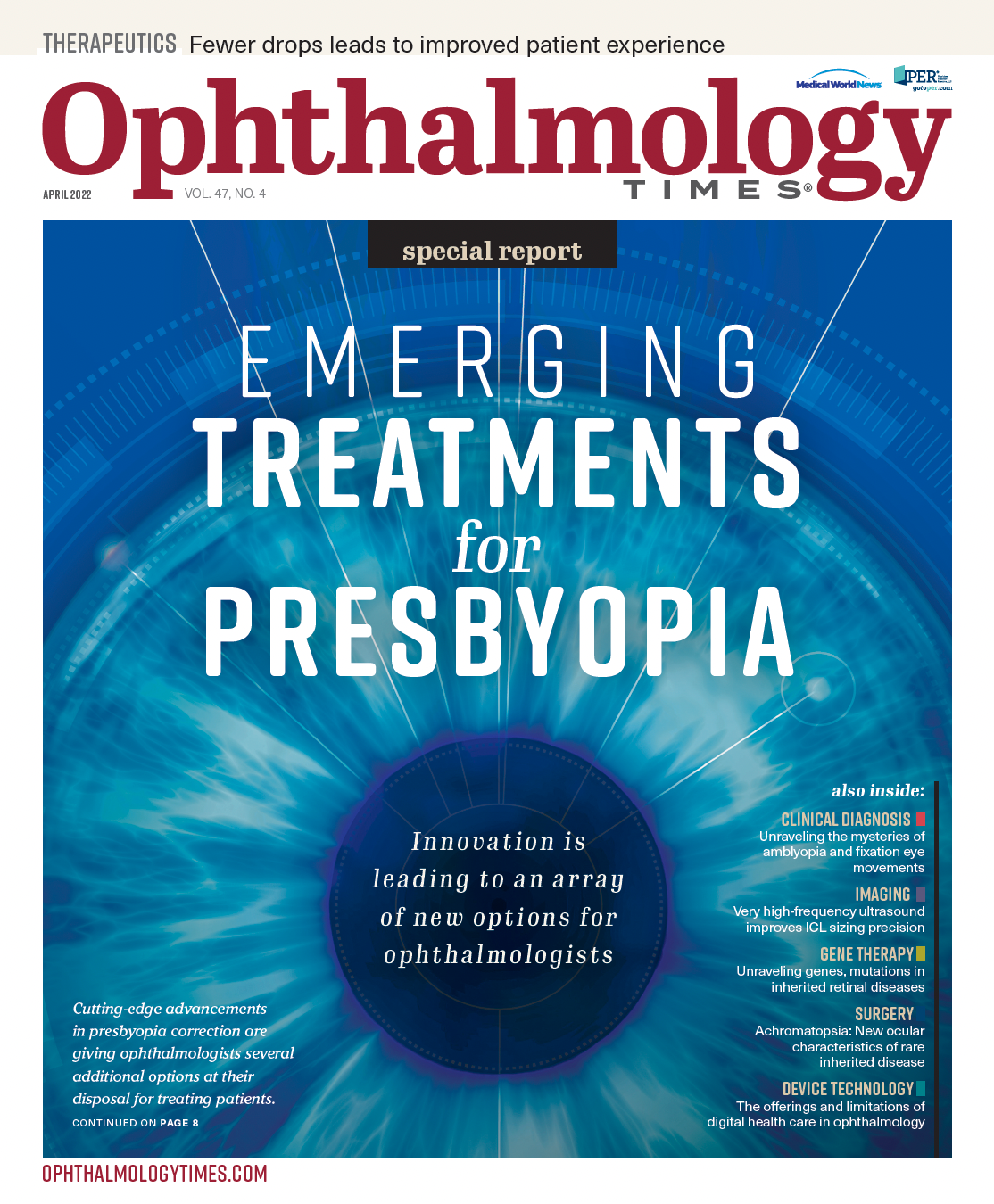Publication
Article
Digital Edition
Emerging medical and surgical presbyopic treatments
Author(s):
Ophthalmologists have several options at their disposal for the treatment of presbyopia, according to Elizabeth Yeu, MD, a partner at Virginia Eye Consultants and an assistant professor at Eastern Virginia Med¬ical School in Norfolk. Speaking recently at the virtual 2022 Toronto Cataract Course, Yeu noted that innovation is advancing in presbyopia correction.
Reviewed by Elizabeth Yeu, MD

Ophthalmologists have several options at their disposal for the treatment of presbyopia, according to Elizabeth Yeu, MD, a partner at Virginia Eye Consultants and an assistant professor at Eastern Virginia Medical School in Norfolk. Speaking recently at the virtual 2022 Toronto Cataract Course, Yeu noted that innovation is advancing in presbyopia correction. “We have spent a very long time without much in the way of innovation beyond the realm of glasses and lenses,” Yeu said. “It is a booming field. We know there are a lot of presbyopes worldwide, and the market [for presbyopia management] is huge. It is only growing exponentially.”
There are noninvasive options for presbyopia correction, such as glasses, multifocal contacts, and eye drops. Additionally, surgical options include LASIK, inlays, and refractive lens exchange, Yeu explained. “There [are] a variety of different miotic drops being used, some individually and some in combination [with another treatment],” she said.
The key measurement of efficacy used by the US Food and Drug Administration (FDA) is an improvement in vision of 2 to 3 lines in a 6-hour window, Yeu noted. Some drop options include FDA-approved Vuity, which has pilocarpine as the active ingredient and is a miotic. Brimochol is an investigational treatment that offers near vision improvement and is a combination of carbachol with brimonidine tartrate.
One of the considerations with topical formulations to correct presbyopia is bioavailability. “A better formulation means better bioavailability and a reduced concentration [of the active ingredient] so there are fewer [adverse] effects, [such as] blurred vision, headaches, and brow aches,” Yeu said.
Moreover, another treatment option under investigation in eye drops includes CSF-1 by Orasis Pharmaceuticals, which uses a lower concentration of pilocarpine. PRX-100 is also a miotic therapy, which has aceclidine as an active ingredient. Another novel therapy under investigation is a combination of phentolamine mesylate and pilocarpine, known as Nyxol, which acts as a miotic and vasodilates small muscles, Yeu explained.
One of the novel topical agents is lipoic acid choline ester, which is made to soften the lens and can work in conjunction with a miotic agent to promote accommodation. Another combination to correct presbyopia is True Vision Treatment contact lenses and eye drop kit by Yolia Health, which is a treatment designed to alter the cornea.
Collagen cross-linking may also potentially represent an option in presbyopia correction. “Instead of using it centrally for myopia or keratoconus, if we were to use it in the midperiphery, creating an effective steepening of the center, this could be used for [patients with presbyopia],” Yeu said, noting that anterior optical coherence tomography images display the central steepening that collagen cross-linking can create.
Synthetic inlays may not be very well tolerated by the human cornea, but allogenic inlays, which are extremely thin, may hold promise, according to Yeu. “If we can get rid of the antigenicity of it, the scaling potential is huge,” she said. “There can be a 3-line improvement in a patient’s near vision improvement.”
One of the factors to consider is ocular rigidity and its impact on presbyopia. “Ocular rigidity is a source of presbyopia in multiple ways,” she said. “It causes scleral rigidity and makes it worse in terms of what happens in the zonules. There is increased lens stiffening.”
A procedure known as laser scleral microporation targets scleral rigidity by “uncross-linking,” potentially helping with biomechanical softening, improving ciliary muscle efficacy to relax the zonules, reshaping the lens during accommodation, and minimizing positive spherical aberration, Yeu explained. She also noted that 10-year data on patients suggest that 3-line improvement in near vision is maintained.
Ophthalmologists have a variety of lenses available for presbyopia correction, including trifocal IOLs, bifocal IOLs, monofocal IOLs, enhanced monofocal IOLs, enhanced trifocal IOLs, and extended depth of focus (EDOF) IOLs. “The enhanced monofocal [IOL] can be used in any patient [in which] you would use a monofocal lens,” Yeu said. However, Yeu also noted that enhanced monofocals are not classified as EDOF lenses and that presbyopia correction options are being tailored to specific corneal issues, such as post radial keratotomy, post LASIK, keratoconus, and iris trauma.
In selecting IOLs for patients, clinicians must consider a patient’s lifestyle, hobbies, and activities. It is also important to evaluate a patient’s tolerance of visual disturbances, such as halos and rings around lights at night, Yeu explained.
Other exciting options on the horizon for presbyopia correction include modular accommodating lenses, Yeu noted, adding that vision gains in studies are impressive. “[Lenses] are very close to entering phase 3 studies,” Yeu said. “[Lenses] are fluid filled and would provide accommodation. The base is first inserted, followed by the insertion of the optic. Because it is completely filling the bag, no [posterior capsule opacification] has been seen in any of these patients, which is very important.”
The hurdle in integrating this IOL into clinical practice may have to do with concerns about insertion of the base of the IOL. However, Yeu said that advances in presbyopia correction and what is in pipeline are certainly encouraging. “It is exciting to see where we were 5 to 7 years ago vs where we will be 10 years from now, with respect to various options and what we will offer in presbyopia correction,” she said.
Elizabeth Yeu, MD
E: eyeu@cvphealth.com
Yeu is a consultant for and does research with Tarsus Pharmaceuticals and Alcon.

Newsletter
Don’t miss out—get Ophthalmology Times updates on the latest clinical advancements and expert interviews, straight to your inbox.





.png&w=3840&q=75)




























